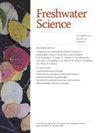Molecular insight reveals broad-scale spatial patterns in floodplain ciliate assemblages, whereas morphology reflects local environmental controls
IF 1.6
4区 环境科学与生态学
Q3 ECOLOGY
引用次数: 0
Abstract
One of the major goals in microbial ecology is to understand whether the empirical biogeographic patterns of macroorganisms also apply to microorganisms. Here, we used morphological data from live organisms, along with molecular data, to investigate the importance of spatial factors and environmental variables in influencing ciliate composition from floodplain lakes. Our main goal was to use 2 different approaches (morphological and molecular) to compare ciliate diversity and distribution patterns as well as to compare how these methods differ in their ability to detect distribution patterns and the roles of spatial and environmental factors that shape ciliate assemblages in the 4 largest floodplains in Brazil. Planktonic water samples were gathered from 33 lakes associated with 4 different river floodplain systems in Brazil. We analyzed ciliates in vivo and sequenced surface water DNA using a metabarcoding approach with general eukaryotic primers. We showed that the diversity of operational taxonomic units was much higher than that of morphospecies. Regardless of the method of identification, we found a consistent spatial assembly pattern of ciliate assemblages across the 4 floodplain systems. We also found that environmental filters had a stronger association with the morphological than with the molecular site-by-site dissimilarities. Meanwhile, biogeographic factors and the distance among sites limited the distribution of molecular-based composition, resulting in strong differences among the floodplain lakes analyzed. This finding suggests that ecological research and biomonitoring activities should find an equilibrium between morphological and molecular approaches because each approach provides unique insights.分子洞察力揭示了漫滩纤毛虫组合的大尺度空间格局,而形态反映了局部环境控制
微生物生态学的主要目标之一是了解大型生物的经验生物地理模式是否也适用于微生物。本文利用生物形态学数据和分子数据,探讨了空间因子和环境变量对河漫滩湖泊纤毛虫组成的影响。我们的主要目标是使用两种不同的方法(形态学和分子)来比较纤毛虫的多样性和分布模式,并比较这些方法在检测分布模式的能力和空间和环境因素的作用方面的差异,这些因素塑造了巴西4个最大的洪泛平原上的纤毛虫组合。从巴西4个不同河流泛滥平原系统的33个湖泊中收集了浮游水样本。我们在体内分析了纤毛虫,并使用一般真核引物的元条形码方法对地表水DNA进行了测序。结果表明,操作分类单位的多样性远高于形态种的多样性。无论采用何种识别方法,我们都发现4个漫滩系统的纤毛虫组合具有一致的空间组合格局。我们还发现,环境过滤器与形态学的关联比与分子位点差异的关联更强。同时,生物地理因素和站点之间的距离限制了分子基组成的分布,导致所分析的河漫滩湖泊之间存在较大差异。这一发现表明,生态学研究和生物监测活动应该在形态和分子方法之间找到平衡,因为每种方法都提供了独特的见解。
本文章由计算机程序翻译,如有差异,请以英文原文为准。
求助全文
约1分钟内获得全文
求助全文
来源期刊

Freshwater Science
ECOLOGY-MARINE & FRESHWATER BIOLOGY
CiteScore
4.10
自引率
0.00%
发文量
49
审稿时长
6-12 weeks
期刊介绍:
Freshwater Science (FWS) publishes articles that advance understanding and environmental stewardship of all types of inland aquatic ecosystems (lakes, rivers, streams, reservoirs, subterranean, and estuaries) and ecosystems at the interface between aquatic and terrestrial habitats (wetlands, riparian areas, and floodplains). The journal regularly features papers on a wide range of topics, including physical, chemical, and biological properties of lentic and lotic habitats; ecosystem processes; structure and dynamics of populations, communities, and ecosystems; ecology, systematics, and genetics of freshwater organisms, from bacteria to vertebrates; linkages between freshwater and other ecosystems and between freshwater ecology and other aquatic sciences; bioassessment, conservation, and restoration; environmental management; and new or novel methods for basic or applied research.
 求助内容:
求助内容: 应助结果提醒方式:
应助结果提醒方式:


